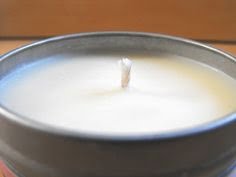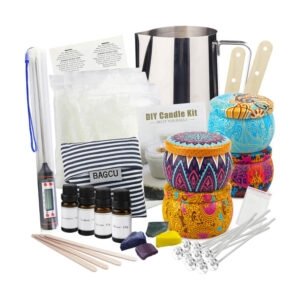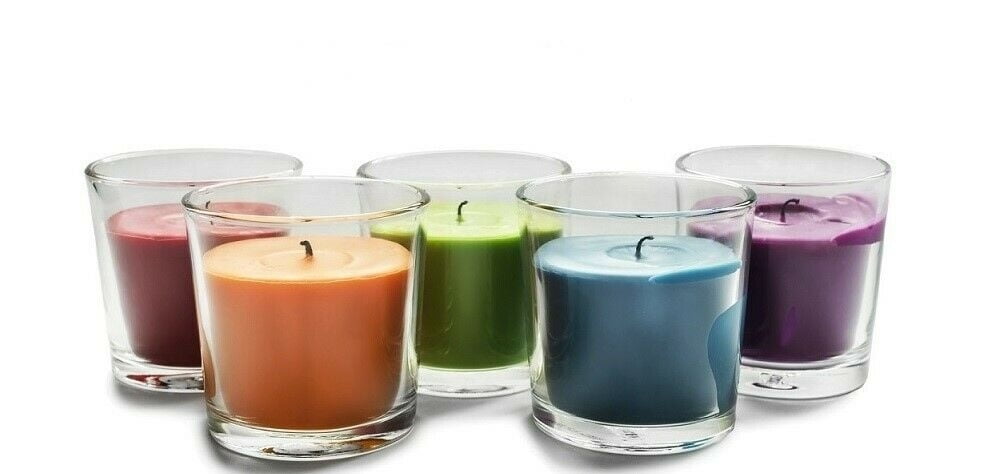Candles are more than just a source of light; they have the power to create ambiance and evoke emotions. One of the key elements in achieving this is the use of color and fragrance. The right combination of colors and scents can transform a simple candle into a sensory experience that delights both visually and aromatically.
Color plays a vital role in setting the mood and enhancing the aesthetic appeal of a candle. Understanding color theory is essential for candle makers who want to create visually pleasing products. Different colors can stimulate various emotions, such as calmness, energy, or romance. By carefully selecting complementary or contrasting colors, candle makers can achieve stunning visual effects that captivate their customers.
Beyond aesthetics, fragrance adds an extra layer of depth to candles. The right scent can transport individuals to another time or place, evoke nostalgia, or create a sense of relaxation and well-being. Natural fragrances, such as essential oils and botanical extracts, are becoming increasingly popular due to their authenticity and eco-friendly nature. However, synthetic fragrances also offer advantages in terms of cost-effectiveness and versatility.
In this article, we will explore the importance of color and fragrance in candle making. We will delve into color theory and discuss how different hues can affect the overall ambiance of a candle. Additionally, we will provide tips for selecting a color palette that complements your desired mood or theme.
We will also delve into the world of fragrance, covering both natural options like essential oils as well as synthetic alternatives. Furthermore, we will guide you through techniques for adding color to your wax while ensuring consistency and intensity. Lastly, we will discuss wick selection for optimal fragrance release and color stability.
Join us on this aromatic journey as we uncover the secrets behind creating candles that not only illuminate but also captivate with their exquisite colors and intoxicating scents.
Understanding Color Theory for Candle Making
Color theory is an essential element to consider when making candles, as it greatly influences the overall aesthetic appeal and ambiance of the finished product. Understanding color theory allows candle makers to create visually pleasing candles that evoke specific emotions and moods.
In candle making, colors are typically divided into different families: warm colors such as reds, oranges, and yellows; cool colors like blues, greens, and purples; and neutral colors like whites, grays, and browns. Each color family has its own unique effect on the atmosphere of a space. For example, warm colors can create a cozy and inviting feeling in a room, while cool colors can promote relaxation or create a soothing environment.
To choose the right color palette for your candle, it is important to consider the symbolism and mood associated with each color. Red is often associated with passion and energy, while blue can represent tranquility and calmness. By understanding these associations, you can select complementary or contrasting colors that help convey the desired emotional impact of your candle.
| Color | Symbolism | Mood |
|---|---|---|
| Red | Passion, Energy | Energetic |
| Blue | Tranquility, Calmness | Soothing |
| Yellow | Happiness, Optimism | Cheerful |
By effectively utilizing color theory in candle making, you can create candles that not only enhance the visual appeal of a space but also evoke specific emotions and moods in individuals. Whether you aim to create a cozy atmosphere with warm tones or promote relaxation with cool colors, understanding color theory allows for a more intentional and impactful candle-making process.
Choosing the Right Color Palette for Your Candle
When it comes to candle making, choosing the right color palette is essential for creating a visually appealing and aesthetically pleasing product. The colors you choose for your candles can have a significant impact on the overall ambiance and mood they convey.
Whether you want to create a cozy and warm atmosphere or a vibrant and energetic vibe, selecting the right colors is key. Here are some tips and tricks to help you choose the perfect color palette for your candle:
- Complementary or Contrasting Colors: One approach to selecting colors for your candle is choosing complementary or contrasting shades. Complementary colors are those that are opposite each other on the color wheel, such as blue and orange, or red and green. These combinations create a high contrast and can make your candle visually striking.
On the other hand, contrasting colors are those that are near each other on the color wheel but differ in hue, such as pink and purple or yellow and orange. These combinations offer a harmonious yet vibrant look for your candle. - Symbolism and Mood: Colors have symbolic meanings and evoke certain moods or emotions. Consider the symbolism associated with different colors when choosing your candle palette. For example, green is often associated with nature, growth, and harmony, while red represents passion, energy, and warmth. Think about the mood you want to convey through your candles – calmness, happiness, relaxation – and select colors accordingly.
- Experimentation: Don’t be afraid to experiment with different color combinations to find what works best for your candles. Mix different shades within a color family or try using pastels for a softer look. You can also create unique effects by blending two or more colors together in your melted wax before pouring it into the mold.
Remember that color intensity may vary once the wax sets, so always test small batches of colored wax before committing to larger quantities. The right color palette can elevate your candles from ordinary to extraordinary, so take the time to explore different options and find combinations that truly reflect your desired aesthetic.
Utilizing Natural Fragrances in Candle Making
In today’s world, there is a growing demand for natural and eco-friendly products. When it comes to candle making, using natural fragrances not only enhances the overall experience but also aligns with the desire for authenticity and sustainability. Natural fragrances offer a wide range of scents that can elevate your candles to a whole new level of luxury and wellness.
Benefits of Using Natural Fragrances
One of the main advantages of using natural fragrances in candle making is their authenticity. Natural fragrances are derived from plants, flowers, fruits, and herbs, resulting in scents that are pure and true to nature. These fragrances evoke a sense of tranquility and connection with the environment.
Moreover, natural fragrances contribute to a more eco-friendly candle-making process. Unlike synthetic fragrances that often contain harmful chemicals or toxins, natural fragrance options such as essential oils and botanical extracts are generally considered safe and sustainable. By choosing natural fragrances, you support a greener approach to candle making.
Popular Natural Fragrance Options
When it comes to natural fragrances for candles, essential oils are undoubtedly a popular choice. Essential oils are concentrated plant extracts known for their therapeutic properties. You can find essential oils derived from various plants, including lavender, eucalyptus, vanilla, citrus fruits, and many more. Each essential oil brings its own unique aroma profile and potential health benefits to your candles.
Another option for incorporating natural fragrance into your candles is through botanical extracts. These extract essences from different parts of plants such as leaves, stems, flowers or roots can provide distinct scents like rosemary or chamomile that can add complexity to your blend.
It’s important to note that when working with natural fragrances like essential oils or botanical extracts in candle making, it’s crucial to follow recommended guidelines for proper usage and dilution to ensure safety and effectiveness.
Incorporating Synthetic Fragrances in Candle Making
Synthetic fragrances offer a wide range of scents that can enhance your candle making experience. While natural fragrances are popular for their authenticity and eco-friendliness, synthetic fragrances have their own advantages. This section will explore the benefits of incorporating synthetic fragrances into your candle making process and provide guidelines for safe usage.
The Advantages of Synthetic Fragrances
One of the main advantages of using synthetic fragrances in candle making is the ability to mimic a variety of scents that may not be readily available in nature. These synthetic fragrance oils are formulated by perfumers and chemists to replicate familiar smells such as fresh laundry, island breezes, or even specific foods like vanilla cupcake or coffee. By using synthetic fragrance oils, you can create candles with unique and intriguing scents that cannot be achieved with natural fragrances alone.
Another benefit of synthetic fragrances is their consistency. Natural essential oils can vary in scent from batch to batch due to crop conditions and harvesting times. Synthetic fragrance oils, however, have a consistent scent profile, allowing you to achieve reliable results every time you make candles. This can be particularly useful if you plan on selling your candles or want to recreate a particular scent frequently.
Safety Precautions and Guidelines
When working with synthetic fragrances, it’s important to prioritize safety. Some individuals may have sensitivities or allergies to certain chemicals commonly found in synthetic fragrance oils. Therefore, always make sure to test a small sample of the fragrance oil before incorporating it into your entire batch of wax. This will help you identify any potential adverse reactions and ensure the safety of your product.
Additionally, it’s crucial to follow manufacturer guidelines when using synthetic fragrances in candle making. Different fragrance oils may require different concentrations or temperature ranges for optimal performance and safety. Consult the instructions provided by the fragrance oil supplier or manufacturer for accurate usage recommendations.
Adding Color to Your Wax
When making candles, adding color to the wax is an important step in creating visually appealing and personalized products. The color of a candle can greatly enhance its aesthetic appeal and overall ambiance, making it a key consideration for candle makers. In this section, we will explore different techniques and tips for adding color to your wax effectively.
There are several methods that can be used to add color to candle wax. One common technique is using dye chips or blocks specifically designed for candle making. These dye chips come in a variety of colors and can be melted directly into the wax during the melting process. It is important to note that different amounts of dye chips may be required depending on the desired color intensity.
Liquid dyes are another popular option for coloring candle wax. These dyes are highly concentrated and can be added drop by drop until the desired shade is achieved. It is important to mix the liquid dye thoroughly with the melted wax to ensure even distribution of color throughout the candle.
For those who prefer natural alternatives, there are options available such as mica powders and powdered pigments derived from plants or minerals. These natural coloring agents can be mixed into the melted wax and provide a more organic touch to your candles.
To achieve consistent and vibrant colors, it is recommended to experiment with small test batches before making larger quantities of candles. This allows you to adjust the amount of colorant used and ensure that you are satisfied with the final result.
| Coloring Technique | Description |
|---|---|
| Dye Chips/Blocks | Solid colored chips or blocks that can be melted directly into wax |
| Liquid Dyes | Highly concentrated liquid dyes that can be added drop by drop |
| Natural Alternatives | Mica powders or powdered pigments derived from plants or minerals |
Blending Fragrances
When it comes to candle making, one of the most exciting aspects is creating unique scent combinations. Blending fragrances allows you to unleash your creativity and develop candles that are truly one-of-a-kind. By combining different scents, you can create a personalized aroma that suits your preferences or satisfies the preferences of your customers.
To start blending fragrances, it’s important to have a basic understanding of the different fragrance families. These families include floral, fruity, herbal, woody, and spicy. Each family has its own characteristics and aroma profiles, which can be used as a starting point for creating blends. For example, you might choose to combine a floral scent with a fruity scent for a fresh and vibrant combination.
To create harmonious scent combinations, consider using top, middle, and base notes when blending fragrances. Top notes are the first scents that are detected and usually last for around 15 minutes after the candle is lit. Examples of top notes include citrus fruits like lemon or orange. Middle notes emerge after the top notes fade away and are long-lasting.
Examples of middle notes include floral scents like jasmine or rose. Base notes are deep scents that last throughout the entire burn time of the candle. Examples of base notes include musk or vanilla.
Here are some tips for successfully blending fragrances:
- Start by combining scents from different fragrance families to achieve balance and complexity.
- Begin with small quantities and test each blend before committing to larger batches.
- Keep track of your experiments by making detailed notes on each blend’s ratio and description.
- Experiment with different ratios to find the ideal combination that matches your desired aroma profile.
- Consider the season or occasion when selecting fragrance combinations; for example, warm spices might be more appropriate during colder months while fresh florals may be better suited for springtime.
Remember, blending fragrances is an art form that requires patience and experimentation. There are endless possibilities for creating unique scent combinations, so don’t be afraid to let your creativity soar and discover new aromatic delights in the world of candle making.
Choosing the Right Wick for Your Candle
Choosing the right wick for your candle is a crucial step in ensuring optimal fragrance release and color stability. The wick plays a significant role in how evenly your candle burns, how well the fragrance is dispersed, and how long your candle will last. With so many options to choose from, it can be overwhelming to find the perfect wick for your specific needs.
When selecting a wick, consider the size of your candle and the type of fragrance you are using. A larger candle will require a thicker wick to provide enough heat to melt the wax evenly across its surface. On the other hand, a smaller candle may need a thinner wick to prevent excessive heat that can cause melting or tunneling.
Additionally, some fragrances have different flashpoints, which is the temperature at which they start to evaporate. It’s important to choose a wick that can generate enough heat to properly release the fragrance while not burning too hot and causing discoloration or other safety issues.
There are various types of wicks available, such as cotton core wicks, zinc core wicks, and wooden wicks. Cotton core wicks are commonly used in candle making as they provide a consistent burn and work well with most fragrances. Zinc core wicks are ideal for candles with high fragrance loads or those containing essential oils as they offer excellent scent throw. Wooden wicks provide a unique crackling sound when lit and create an elegant aesthetic appeal.
In conclusion, selecting the right wick for your candle is essential for achieving an optimal fragrance experience and color stability. Consider factors like candle size and fragrance type when choosing a suitable wick. Experimentation may be necessary to find the perfect match for your specific needs. By choosing the right wick, you can ensure that your candles burn beautifully while releasing delightful fragrances that enhance any space. Happy candle making.

Welcome to my candle making blog! In this blog, I will be sharing my tips and tricks for making candles. I will also be sharing some of my favorite recipes.





